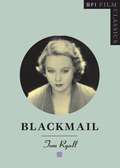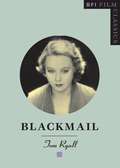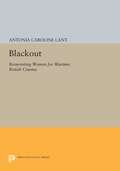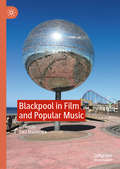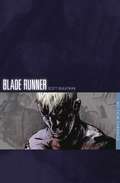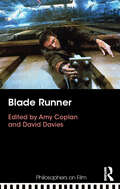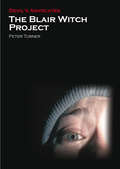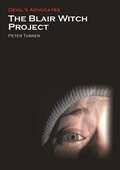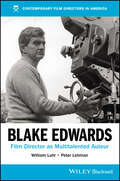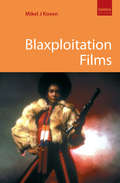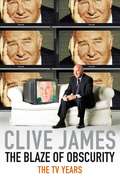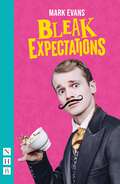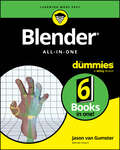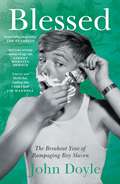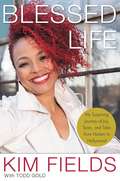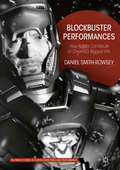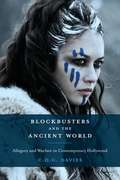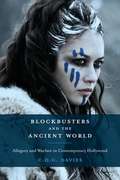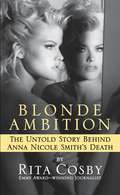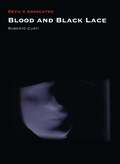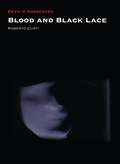- Table View
- List View
Blackmail (BFI Film Classics)
by Tom RyallAlfred Hitchcock's Blackmail (1929) was the first major British sound film. Tom Ryall examines its unusual production history, and places it in the context of Hitchcock's other British films of the period. Is is, Ryall argues, both a considerable work of art in itself, and also one of the first to display those touches we now think of as typically Hitchcockian: a blonde heroine in jeopardy, a surprise killing, some brilliantly manipulated suspense, and a last-reel chase around a familiar public landmark (in this case, the British Museum). There's also a cameo appearance by the director himself, as a harassed traveller on the London Underground.
Blackmail (BFI Film Classics)
by Tom RyallAlfred Hitchcock's Blackmail (1929) was the first major British sound film. Tom Ryall examines its unusual production history, and places it in the context of Hitchcock's other British films of the period. Is is, Ryall argues, both a considerable work of art in itself, and also one of the first to display those touches we now think of as typically Hitchcockian: a blonde heroine in jeopardy, a surprise killing, some brilliantly manipulated suspense, and a last-reel chase around a familiar public landmark (in this case, the British Museum). There's also a cameo appearance by the director himself, as a harassed traveller on the London Underground.
Blackout: Reinventing Women for Wartime British Cinema (PDF)
by Antonia Caroline LantThe most universal civilian privation in World War II Britain, the blackout possessed many symbolic meanings. Among its complicated implications for filmmakers was a stigmatization of film spectacle--including the display of "Hollywood women," whose extravagant appearance connoted at best unpatriotic wastefulness and at worst collaboration with the enemy. Exploring the wartime breakdown of conventional gender roles on the screen and in the audience, Antonia Lant demonstrates that many British films of the period signaled their national cinematic identity by diverging from the notion of the Hollywood star, the mainstay of commercial American motion pictures, replacing her with a deglamourized, mobilized heroine. Nevertheless, the war machine demanded that British films continue to celebrate stable and reassuring gender roles. Contradictions abounded, both within film narratives and between narrative and "real life." Analyzing films of all the major wartime studios, the author scrutinizes the efforts of realist and melodramatic texts to confront women's wartime experiences, including conscription. By combining study of contemporary posters, advertisements, propaganda notices, and cartoons with consideration of recent feminist theoretical work on the cinema, spectatorship, and history, she has produced the first book to examine the relationships among gender, cinema, and nationality as they are affected by the stresses of war.Originally published in 1991.The Princeton Legacy Library uses the latest print-on-demand technology to again make available previously out-of-print books from the distinguished backlist of Princeton University Press. These editions preserve the original texts of these important books while presenting them in durable paperback and hardcover editions. The goal of the Princeton Legacy Library is to vastly increase access to the rich scholarly heritage found in the thousands of books published by Princeton University Press since its founding in 1905.
Blackpink: K-Pop's No.1 Girl Group
by Adrian BesleyA comprehensive guide to the K-pop girl group who are taking the music world by storm. The sassiest, most stylish girls around – BLACKPINK!‘Blackpink in Your Area!’ The K-pop girl group are taking their catchphrase literally; they have just finished a sell-out stadium world tour. Jisoo, Jennie, Rosé and Lisa, all beautiful and supremely talented women in their early 20s, are the hottest thing in pop right now – and they only have a dozen songs! If Blackpink were ever a secret, the secret was out by April 2019, when they headlined Coachella, and their fandom – known as Blinks – suddenly included Ariana Grande and Harry Styles. They are the first female K-pop group to have had four #1 singles on Billboard's World Digital chart, and their single ‘Ddu-Du Ddu-Du’ became the most viewed music video by a K-pop group on YouTube – take that, BTS!This book is the perfect unofficial guide to Blackpink. It relates their days as trainees, their debut, their hits and success in the US, examines the personalities of each of the members and details their choreography, fashion and style triumphs and reveals why they are ‘the only gang to run the game in high heels’.
Blackpool in Film and Popular Music
by Ewa MazierskaThis collection examines Blackpool, Britain’s first and largest working-class seaside resort as a location for the production and consumption of British film and popular music, and the meaning of ‘Blackpool’ in films and songs. It examines representation of Blackpool in films such as Hindle Wakes, A Taste of Honey, Bhaji on the Beach, Away, Bob’s Weekend, The Harry Hill Movie and Miss Peregrine's Home for Peculiar Children, linking it to the concepts of heterotopia, purgatory, fantasy, simulacra and the carnivalesque. It also presents music in Blackpool through the history of its venues and examines development of punk and grime music in this seaside town. The authors argue that Blackpool in filmic and musical texts often stands for British culture, but increasingly for culture which is remembered or imagined rather than present and real.
Blade Runner (BFI Film Classics)
by Scott BukatmanRidley Scott's dystopian classic Blade Runner, an adaptation of Philip K. Dick's novel, Do Androids Dream of Electric Sheep?, combines noir with science fiction to create a groundbreaking cyberpunk vision of urban life in the twenty-first century. With replicants on the run, the rain-drenched Los Angeles which Blade Runner imagines is a city of oppression and enclosure, but a city in which transgression and disorder can always erupt. Graced by stunning sets, lighting, effects, costumes and photography, Blade Runner succeeds brilliantly in depicting a world at once uncannily familiar and startlingly new. In his innovative and nuanced reading, Scott Bukatman details the making of Blade Runner and its steadily improving fortunes following its release in 1982. He situates the film in terms of debates about postmodernism, which have informed much of the criticism devoted to it, but argues that its tensions derive also from the quintessentially twentieth-century, modernist experience of the city – as a space both imprisoning and liberating. In his foreword to this special edition, published to celebrate the 20th anniversary of the BFI Film Classics series, Bukatman suggests that Blade Runner 's visual complexity allows it to translate successfully to the world of high definition and on-demand home cinema. He looks back to the science fiction tradition of the early 1980s, and on to the key changes in the 'final' version of the film in 2007, which risk diminishing the sense of instability created in the original.
Blade Runner (Philosophers on Film)
by David Davies Amy CoplanRidley Scott’s Blade Runner is widely regarded as a "masterpiece of modern cinema" and is regularly ranked as one of the great films of all time. Set in a dystopian future where the line between human beings and ‘replicants’ is blurred, the film raises a host of philosophical questions about what it is to be human, the possibility of moral agency and freedom in ‘created’ life forms, and the capacity of cinema to make a genuine contribution to our engagement with these kinds of questions. This volume of specially commissioned chapters systematically explores and addresses these issues from a philosophical point of view. Beginning with a helpful introduction, the seven chapters examine the following questions: How is the theme of death explored in Blade Runner and with what implications for our understanding of the human condition? What can we learn about the relationship between emotion and reason from the depiction of the ‘replicants’ in Blade Runner? How are memory, empathy, and moral agency related in Blade Runner? How does the style and ‘mood’ of Blade Runner bear upon its thematic and philosophical significance? Is Blade Runner a meditation on the nature of film itself? Including a brief biography of the director and a detailed list of references to other writings on the film, Blade Runner is essential reading for students – indeed anyone - interested in philosophy and film studies. Contributors: Colin Allen, Peter Atterton, Amy Coplan, David Davies, Berys Gaut, Stephen Mulhall, C. D. C. Reeve.
Blade Runner (Philosophers on Film)
by David Davies Amy CoplanRidley Scott’s Blade Runner is widely regarded as a "masterpiece of modern cinema" and is regularly ranked as one of the great films of all time. Set in a dystopian future where the line between human beings and ‘replicants’ is blurred, the film raises a host of philosophical questions about what it is to be human, the possibility of moral agency and freedom in ‘created’ life forms, and the capacity of cinema to make a genuine contribution to our engagement with these kinds of questions. This volume of specially commissioned chapters systematically explores and addresses these issues from a philosophical point of view. Beginning with a helpful introduction, the seven chapters examine the following questions: How is the theme of death explored in Blade Runner and with what implications for our understanding of the human condition? What can we learn about the relationship between emotion and reason from the depiction of the ‘replicants’ in Blade Runner? How are memory, empathy, and moral agency related in Blade Runner? How does the style and ‘mood’ of Blade Runner bear upon its thematic and philosophical significance? Is Blade Runner a meditation on the nature of film itself? Including a brief biography of the director and a detailed list of references to other writings on the film, Blade Runner is essential reading for students – indeed anyone - interested in philosophy and film studies. Contributors: Colin Allen, Peter Atterton, Amy Coplan, David Davies, Berys Gaut, Stephen Mulhall, C. D. C. Reeve.
The Blair Witch Project (Devil's Advocates)
by Peter TurnerFew films have had the influence and impact of The Blair Witch Project (1999). Its arrival was a horror cinema palette cleanser after a decade of serial killers and postmodern intertextuality, a bare bones 'found footage' trend setter. In this Devil's Advocate, Peter Turner tells the story of the film from his conception and production then provides a unique analysis of the techniques used, their appeal to audiences and the themes that helped make the film such an international hit, including the pionerring internet marketing.
The Blair Witch Project (Devil's Advocates)
by Peter TurnerFew films have had the influence and impact of The Blair Witch Project (1999). Its arrival was a horror cinema palette cleanser after a decade of serial killers and postmodern intertextuality, a bare bones 'found footage' trend setter. In this Devil's Advocate, Peter Turner tells the story of the film from his conception and production then provides a unique analysis of the techniques used, their appeal to audiences and the themes that helped make the film such an international hit, including the pionerring internet marketing.
Blake Edwards: Film Director as Multitalented Auteur (Film Directors in America)
by William Luhr Peter LehmanBLAKE EDWARDS Blake Edwards: Film Director as Multitalented Auteur is the first critical analysis to focus on the dramatic works of Blake Edwards. Best known for successful comedies such as The Pink Panther series with Peter Sellers, Blake Edwards wrote, produced, and directed serious works in radio, television, film, and theater for seven decades. Although hit films such as Breakfast at Tiffany’s and ‘10’ remain popular, many of Edwards’s dramas have been forgotten or marginalized. In this unique book, William Luhr and Peter Lehman draw on original research from numerous set visits and personal interviews with Edwards and many of his creative and business collaborators to explore his dramas, radio and television work, theatrical productions, one-man art shows, and unproduced screenplays. In-depth chapters analyze non-comedic films including Experiment in Terror, Days of Wine and Roses, and The Tamarind Seed, the theatrical feature film Gunn and the made-for-television film Peter Gunn, the musical adaptation of Victor/Victoria, and lesser-known films written but not directed by Edwards, such as Drive a Crooked Road. Throughout the book, the authors apply contemporary film theory to auteur criticism of different works while sharing original insights into how Edwards worked creatively in disparate genres and media using composition, editing, sound, and visual motifs to shape his films and radio and television series. A one-of-a-kind examination of one of the most influential film directors of his generation, Blake Edwards: Film Director as Multitalented Auteur is an excellent supplementary text for university courses in American cinema, genres, auteurs, and film criticism, and a must-read for critics, scholars, and general readers interested in the works of Blake Edwards.
Blake Edwards: Film Director as Multitalented Auteur (Film Directors in America)
by William Luhr Peter LehmanBLAKE EDWARDS Blake Edwards: Film Director as Multitalented Auteur is the first critical analysis to focus on the dramatic works of Blake Edwards. Best known for successful comedies such as The Pink Panther series with Peter Sellers, Blake Edwards wrote, produced, and directed serious works in radio, television, film, and theater for seven decades. Although hit films such as Breakfast at Tiffany’s and ‘10’ remain popular, many of Edwards’s dramas have been forgotten or marginalized. In this unique book, William Luhr and Peter Lehman draw on original research from numerous set visits and personal interviews with Edwards and many of his creative and business collaborators to explore his dramas, radio and television work, theatrical productions, one-man art shows, and unproduced screenplays. In-depth chapters analyze non-comedic films including Experiment in Terror, Days of Wine and Roses, and The Tamarind Seed, the theatrical feature film Gunn and the made-for-television film Peter Gunn, the musical adaptation of Victor/Victoria, and lesser-known films written but not directed by Edwards, such as Drive a Crooked Road. Throughout the book, the authors apply contemporary film theory to auteur criticism of different works while sharing original insights into how Edwards worked creatively in disparate genres and media using composition, editing, sound, and visual motifs to shape his films and radio and television series. A one-of-a-kind examination of one of the most influential film directors of his generation, Blake Edwards: Film Director as Multitalented Auteur is an excellent supplementary text for university courses in American cinema, genres, auteurs, and film criticism, and a must-read for critics, scholars, and general readers interested in the works of Blake Edwards.
Blaxploitation Films
by Mikel J KovenWhat is Blaxploitation? In the early 1970s a type of film emerged that featured all- black casts, really cool soul, R 'n' B and disco music soundtracks, characters sporting big guns, big dashikis, and even bigger 'fros, and had some of the meanest, baddest attitudes to shoot their way across our screens. More than that, for African-American audiences these films were an antidote to the sanitised 'safe' images of blackness that Sidney Poitier and Bill Cosby presented to America. These films depicted a reality about the world which African-American audiences could identify with, even if the stories themselves were pure fantasy. Blaxploitation Films considers Blaxploitation from the perspective of class and racial rebellion, genre - and Stickin' it to the Man, with over 60 films reviewed and discussed, from horror films and kung-fu movies, to Westerns and parodies. Fully up to date, including Baadassss and The Hebrew Hammer and covers the deaths of Isaac Hayes and Rudy Rae Moore.
The Blaze of Obscurity: Unreliable Memoirs V (Unreliable Memoirs #5)
by Clive James‘I was never alone except in the toilet, where I soon found that locking myself into a cubicle was not much protection from hearing myself talked about by young men standing at urinals. (“Jesus, he’s looking rough.” “And it’s only Monday.”) Reviews for Clive James’s fourth volume of memoirs, North Face of Soho, included several that specifically requested a further volume; Clive James duly obliged and here, in all its glory, is ‘Unreliable Memoirs V’, otherwise known as The Blaze of Obscurity. Perhaps his most brilliant book yet, The Blaze of Obscurity tells the inside story of his years in television: it shows Clive James on top form – both then and now. ‘In the case of many people who attempt an autobiography even a single volume is one too many . . . In the case of Clive James, the volumes now in existence are too few. If the final tally puts him up there with Marcel Proust, so much the better’ Financial Times
Blender All-in-One For Dummies
by Jason van GumsterCreate excellent 3D animations with free, open-source software When you’re looking for help with creating animation with Blender, look no further than the top-selling Blender book on the market. This edition of Blender For Dummies covers every step in the animation process, from basic design all the way to finished product. This book walks you through each project phase, including creating models, adding lighting and environment, animating objects, and building a final shareable file. Written by long-time Blender evangelist Jason van Gumster, this deep reference teaches you the full animation process from idea to final vision. With this fun and easy guide, you’re on your way toward making your animation dreams a reality. Set up Blender and navigate the interface Learn how to build models in virtual space Texture, light, and animate your figures—then render your final product Get help and inspiration from the Blender community If you’re new to Blender or an experienced user in need of a reference, Blender For Dummies is the easy-to-use guide for you.
Blender All-in-One For Dummies
by Jason van GumsterCreate excellent 3D animations with free, open-source software When you’re looking for help with creating animation with Blender, look no further than the top-selling Blender book on the market. This edition of Blender For Dummies covers every step in the animation process, from basic design all the way to finished product. This book walks you through each project phase, including creating models, adding lighting and environment, animating objects, and building a final shareable file. Written by long-time Blender evangelist Jason van Gumster, this deep reference teaches you the full animation process from idea to final vision. With this fun and easy guide, you’re on your way toward making your animation dreams a reality. Set up Blender and navigate the interface Learn how to build models in virtual space Texture, light, and animate your figures—then render your final product Get help and inspiration from the Blender community If you’re new to Blender or an experienced user in need of a reference, Blender For Dummies is the easy-to-use guide for you.
Blessed: The Breakout Year of Rampaging Roy Slaven
by John DoyleWho is Rampaging Roy Slaven? An Australian icon, a raconteur, an athlete of unsurpassable - and some may say improbable - sporting feats. Whether it was riding Rooting King to another Melbourne Cup victory, commentating the Olympics or hobnobbing with the country's upper crust, Rampaging Roy Slaven has lived an extraordinary life.But even some of the greatest men come from humble beginnings. Before he shot to fame as Australia's most talented sportsman, he was just another kid in Lithgow, trying to avoid Brother Connell's strap and garner the attention of Susan Morgan from the local Catholic girls school.Blessed follows one year in the life of the boy who would become Rampaging Roy Slaven, a boy who, even at the age of fifteen, knew he was destined for greatness but had to get through high school first.
Blessed Life: My Surprising Journey of Joy, Tears, and Tales from Harlem to Hollywood
by Kim FieldsFrom "Facts of Life" to "Living Single" to "Dancing with the Stars" to wife and mom, here's the BLESSED LIFE of Kim Fields, veteran actress, TV personality, and star. Kim Fields has lived most of her life with people thinking they know her, which is understandable. From her first job on a Mrs. Butterworth syrup commercial at age 7, she has spent 40 years in the public eye. There were 9 years as Dorothy "Tootie" Ramsey on the classic sitcom The Facts of Life, 5 more in her 20s starring as Regine Hunter on the seminal coming-of-age show Living Single, and most recently appearing as herself on Real Housewives of Atlanta and Dancing with the Stars. Behind the camera, she has directed episodes of Kenan & Kel, Tyler Perry's Meet the Browns and House of Payne, and BET's Let's Stay Together. Between gigs, the pop culture icon's life has included theater, spoken word, music, speaking engagements, and simply being present to the point that she cannot go a day without someone stopping her to say, "When I was a kid, I wanted to be Tootie" or "You were my role model." Flattered and blessed, after four decades in the business, Kim finally understands the role she has played onscreen and off as a successful, outspoken African-American woman. However, for as much as she's been in the public eye, people have really never known her the way they think they have, and that's because she, herself, spent most of her life figuring herself out. Now, at age 48, she is ready to set the record straight. She says, "It's not that I've been misunderstood. It's that I finally feel like I understand me enough to tell the life story that I've been asked to write for years." It will be a chronicle of living, learning, and keen moments of self-discovery as she's journeyed through the many facets and chapters of life. Fields found faith at age 14 and has found God to be right there every step of the way since then.
Blockbuster Performances: How Actors Contribute to Cinema’s Biggest Hits (Palgrave Studies in Screen Industries and Performance)
by Daniel Smith-RowseyThis book examines performances in the American film industry’s highest-earning and most influential films. Countering decades of discourse and the conventional notion that special effects are the real stars of Hollywood blockbusters, this book finds that the acting performances in these big-budget action movies are actually better, and more genre-appropriate, than reputed. It argues that while blockbusters are often edited for speed, thrills, and simplicity, and performances are sometimes tailored to this style, most major productions feature more scenes of stage-like acting than hyper-kinetic action. Knowing this, producers of the world’s highest-budgeted motion pictures usually cast strong or generically appropriate actors. With chapters offering unique readings of some of cinema’s biggest hits, such as The Dark Knight, Pirates of the Caribbean, Star Wars, Iron Man and The Hunger Games, this unprecedented study sheds new light on the importance of performance in the Hollywood blockbuster.
Blockbusters and the Ancient World: Allegory and Warfare in Contemporary Hollywood
by Chris DaviesFollowing the release of Ridley Scott's Gladiator in 2000 the ancient world epic has experienced a revival in studio and audience interest. Building on existing scholarship on the Cold War epics of the 1950s-60s, including Ben-Hur, Spartacus and The Robe, this original study explores the current cycle of ancient world epics in cinema within the social and political climate created by September 11th 2001. Examining films produced against the backdrop of the War on Terror and subsequent invasions of Iraq and Afghanistan, this book assesses the relationship between mainstream cinema and American society through depictions of the ancient world, conflict and faith. Davies explores how these films evoke depictions of WWII, the Vietnam War and the Western in portraying warfare in the ancient world, as well discussing the influence of genre hybridisation, narration and reception theory. He questions the extent to which ancient world epics utilise allegory, analogy and allusion to parallel past and present in an industry often dictated by market forces. Featuring analysis of Alexander, Troy, 300, Centurion, The Eagle, The Passion of the Christ and more, this book offers new insight on the continued evolution of the ancient world epic in cinema.
Blockbusters and the Ancient World: Allegory and Warfare in Contemporary Hollywood
by Chris DaviesFollowing the release of Ridley Scott's Gladiator in 2000 the ancient world epic has experienced a revival in studio and audience interest. Building on existing scholarship on the Cold War epics of the 1950s-60s, including Ben-Hur, Spartacus and The Robe, this original study explores the current cycle of ancient world epics in cinema within the social and political climate created by September 11th 2001. Examining films produced against the backdrop of the War on Terror and subsequent invasions of Iraq and Afghanistan, this book assesses the relationship between mainstream cinema and American society through depictions of the ancient world, conflict and faith. Davies explores how these films evoke depictions of WWII, the Vietnam War and the Western in portraying warfare in the ancient world, as well discussing the influence of genre hybridisation, narration and reception theory. He questions the extent to which ancient world epics utilise allegory, analogy and allusion to parallel past and present in an industry often dictated by market forces. Featuring analysis of Alexander, Troy, 300, Centurion, The Eagle, The Passion of the Christ and more, this book offers new insight on the continued evolution of the ancient world epic in cinema.
Blonde Ambition: The Untold Story Behind Anna Nicole Smith's Death
by Rita CosbyYOU PROBABLY THINK YOU KNOW ALL THERE IS TO KNOW. ANNA NICOLE SMITH LOST HER SON. SHE ACCIDENTALLY OVERDOSED. SHE WAS A DRUG ADDICT. YOU DON'T KNOW A THING... She was famous for being famous-Americana at its Scarlet Letter-wearing best. A bodacious young girl from Texas, Anna remade herself into the centerfold of the world. She was a "dumb blonde," a stripper, a Playboy Playmate, who boldly took her case against her billionaire husband's family all the way to the U.S. Supreme Court. Her tragic life and untimely death evoke an odd mix of fascination, shock, and dismay. And through it all, there still exists a voracious thirst to discover more about who she actually was...and how she really died. In a book that is sure to surprise even the most avid pop culture junkies, Rita Cosby blows the lid off this astounding story. After an in-depth investigation, this is the definitive journalistic account of the Anna Nicole Smith saga-with unearthed secrets and explosive, never-before-told information.
Blood and Black Lace (Devil's Advocates)
by Roberto CurtiMario Bava’s Blood and Black Lace (1964) is a legendary title, and is commonly considered as the archetypal giallo. A murder mystery about a faceless and menacing killer stalking the premises of a luxurious fashion house in Rome, Blood and Black Lace set the rules for the genre: a masked, black-gloved killer, an emphasis on graphic violence, elaborate and suspenseful murder sequences. But Blood and Black Lace is first and foremost an exquisitely stylish film, full of gorgeous color schemes, elegant camerawork, and surrealistic imagery, testimony of Bava’s mastery and his status as an innovator within popular cinema. This book recollects Blood and Black Lace’s production history, putting it within the context of the Italian film industry of the period and includes plenty of previously unheard-of data. It analyzes its main narrative and stylistic aspects, including the groundbreaking prominence of violence and sadism and its use of color and lighting, as well as Bava’s irreverent approach to genre filmmaking and clever handling of the audience’s expectations by way of irony and pitch-black humor. The book also analyzes Blood and Black Lace’s place within Bava’s oeuvre, its historical impact on the giallo genre, and its influential status on future filmmakers.
Blood and Black Lace (Devil's Advocates)
by Roberto CurtiMario Bava’s Blood and Black Lace (1964) is a legendary title, and is commonly considered as the archetypal giallo. A murder mystery about a faceless and menacing killer stalking the premises of a luxurious fashion house in Rome, Blood and Black Lace set the rules for the genre: a masked, black-gloved killer, an emphasis on graphic violence, elaborate and suspenseful murder sequences. But Blood and Black Lace is first and foremost an exquisitely stylish film, full of gorgeous color schemes, elegant camerawork, and surrealistic imagery, testimony of Bava’s mastery and his status as an innovator within popular cinema. This book recollects Blood and Black Lace’s production history, putting it within the context of the Italian film industry of the period and includes plenty of previously unheard-of data. It analyzes its main narrative and stylistic aspects, including the groundbreaking prominence of violence and sadism and its use of color and lighting, as well as Bava’s irreverent approach to genre filmmaking and clever handling of the audience’s expectations by way of irony and pitch-black humor. The book also analyzes Blood and Black Lace’s place within Bava’s oeuvre, its historical impact on the giallo genre, and its influential status on future filmmakers.
